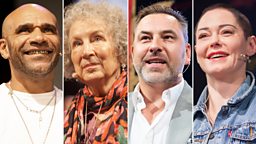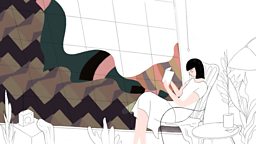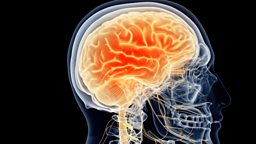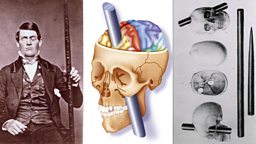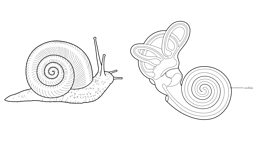Snails, swords and spiders: The odd origins of anatomical terms
22 May 2018
Many of the evocative descriptions used in anatomy have their roots in both the natural and man-made world. , and explore the fascinating evolution of this beautiful science in their book, The Secret Language of Anatomy, which they're presenting at Hay.
Animals
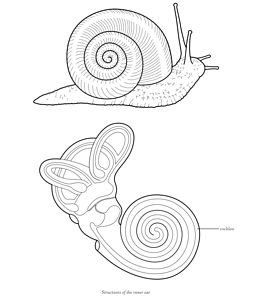
Cochlea
A spiral shell; kokhlias = snail
The cochlea is the spiral chamber of bone in the inner ear which contains the cochlear duct, redolent of a snail’s shell. The cochlea receives and helps to interpret sound vibrations in the process of hearing.
As anatomists came across membranes or bony and cartilaginous prominences during their dissections, they would name them after a wide range of animals which the structures resembled.
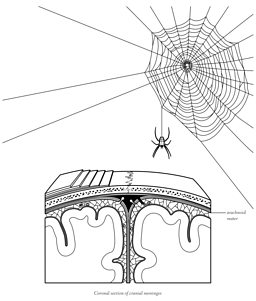
Arachnoid
Cobweb-like; arachne = spider or spider’s web, and -oid from eidos = form
Arachnoid mater is the middle of three layers of membrane surrounding the brain and spinal cord. It has a fine, cobweb-like structure. In the spine, the subarachnoid space refers to the space between the arachnoid mater and pia mater, the innermost layer which adheres to the surface of the spinal cord. It is from this space that samples of cerebrospinal fluid can be removed for diagnostic purposes in a lumbar puncture.

Frenulum
A diminutive of frenum = bridle; the little bridle
A frenulum is a ligament or membrane which acts to secure or restrain the motion of an organ. The frenulum of the tongue is a fold of mucous membrane which attaches from the floor of the mouth to the midline underneath the tongue.
Weaponry
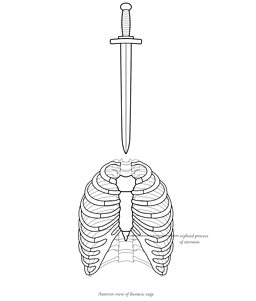
Xiphoid
Sword-shaped
The xiphoid process of the lower sternum resembles the tip of a sword. The xiphoid may be very variable in appearance, and may remain cartilaginous without ossifying to become bone. Several muscles attach to the xiphoid, including the diaphragm, rectus abdominis, and transversus thoracis muscles.
War and surgery go hand in hand... Observing battle wounds improved surgeons' understanding of anatomy. No wonder, therefore, that battlefield objects and weapons provided inspiration for some anatomical terms.
Birds

Pterygoid
Wing- or feather-shaped; from pteryx = wing
The wing-shaped process of the sphenoid bone of the skull. It is an attachment point for the pterygoid muscles, which themselves resemble the contours of a feathered wing.
Of all the imagery deployed by anatomists, that relating to birds is perhaps the most expressive. At any rate, it has a long history.
Music
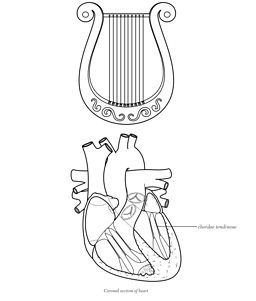
Chord
Catgut, or a string from a musical instrument like a lyre
The chordae tendineae or heart strings are cord-like tendons connecting the papillary muscles to the mitral valve and tricuspid valve in the left and right ventricles of the heart respectively. During ventricular contraction, they function to hold the valves in a closed position to prevent backflow of blood into the atria.
Music has long been considered to have an intimate link to the composition of the human body... The references to musical instruments in anatomy, however, were restricted to parts which closely resembled an instrument in their shape.
Architecture

Septum
A fence, or boundary wall
A partition. Numerous septa exist in the body. The bony nasal septum divides the nasal cavity into two halves. The interatrial and interventricular septa separate the atria and ventricles of the heart respectively. The orbital septum, a fibrous membrane connecting the eyelid and orbital rim, constitutes the anterior boundary of the orbit.
The development and study of Greek and Roman architecture generated a complex vocabulary of its own, bequeathing to anatomists a wide variety of terms with which to describe the apertures, passages and chambers of the human body.
The authors of The Secret Language of Anatomy – Cecilia Brassett, Emily Evans and Isla Fay – will be appearing at the Hay Festival on . The book, published by Lotus Publishing, is available now. Text and illustrations reproduced courtesy of the authors.
